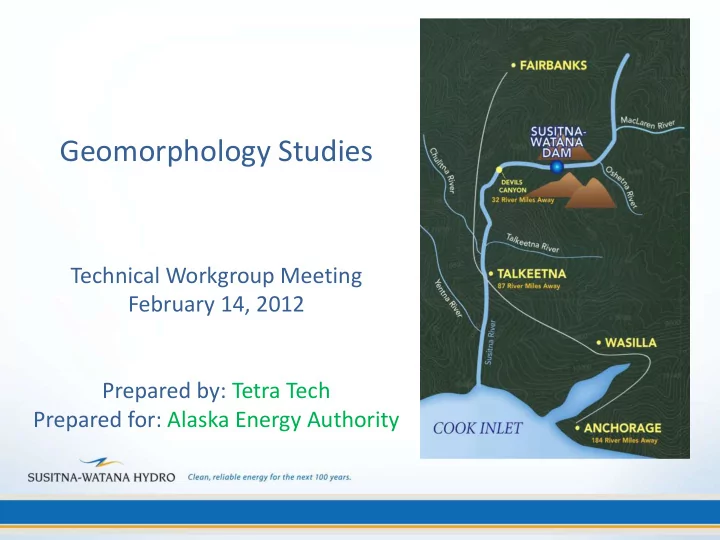

Geomorphology Studies Technical Workgroup Meeting February 14, 2012 Prepared by: Tetra Tech Prepared for: Alaska Energy Authority
2 Overall Goal – Geomorphology Studies • Two studies – Geomorphology Study (RSP 6.5) – Fluvial Geomorphology Modeling Study (RSP 6.6) • The overall goal of the geomorphology studies is to assess the potential effects of the proposed Project on the fluvial geomorphology of the Susitna River, with particular focus on providing information to assist in predicting Project impacts to aquatic and terrestrial habitat.
3 Role of the Geomorphology Studies in Focus Area Selection • Delineate river segments and geomorphic reaches for stratification • Identify channel types for reaches • Consider potential Project effects – Downstream limit – Variation w/ distance below Project • Extent of sites for hydraulic and bed evolution modeling
Geomorphology Study Objectives 4 • Geomorphically characterize the Project-affected river channels and floodplain – Evaluate current and historical aerial photography – Summarize and evaluate available physical data – Collect additional data to fill gaps in existing data and quantify changes from earlier data • Assess potential effects of the Project on physical characteristics of the river • Support studies in other resource areas by providing data and interpretations of potential Project effects to the physical characteristics of the Susitna River
Geomorphology Study Area: 5 Title UR, MR & LR Segments
6 Geomorphology Study Data Collection • Identify and characterize geomorphic reaches (LR, MR, UR) • Mapping & field verification of controls, relic geomorphic forms, etc. (LR, MR) • Sediment transport data collection (LR, MR) • Aerial photo acquisition 2012/13, 1980s, 1950s (Includes UR, primarily LR and MR)
Geomorphology Study 7 Data Collection • LWD survey – aerial & ground (LR, MR, UR) • Reservoir geomorphology (UR) – Reservoir erosions: soils mapping & representative sampling from reservoir fluctuation zone – Tributary delta: cross sections, gradient, bed material samples, site evaluation • Geomorphology of stream crossings – Inspection and assessment (Watershed)
Fluv. Geo. Modeling Study Objectives 8 • Develop and apply 1-D hydraulic and sediment routing models of overall study area – Provide cross section-based hydraulic conditions – Dynamically simulate aggradation/degradation & bed material trends • Develop and apply 2-D hydraulic and sediment transport models at Focus Areas – Provide detailed hydraulic conditions at variable spatial resolution to support aquatic habitat and sediment transport analysis – Dynamically simulate detailed aggradation/degradation and bed material trends within Focus Areas • Support studies in other resource areas by providing data and interpretations of potential Project effects to the physical characteristics of the Susitna River
Fluv. Geo. Modeling Study Area: 9 Title MR & LR Segments
10 Fluvial Geomorphology Modeling Study Reach Scale (1-D) Data Collection • Supplemental cross sections in the MR and LR (80 to 100) • Bed material sampling – At cross sections – Surface and subsurface – Potential winter through ice sampling • Verification of LiDAR for overbanks • Verification and mapping of relic geomorphic features, controls, evidence of extreme events
Fluvial Geomorphology Modeling Study 11 Reach Scale (1-D) Data Collection • Manning’s n -value estimation • Survey water surface elevation for hydraulic calibration • Reach scale observations on erosion and sedimentation processes
Fluvial Geomorphology Modeling Study 12 Example 2-D Mesh – Portage Creek
Fluvial Geomorphology Modeling Study 13 Example 2-D Mesh – Slough 8A
14 Fluvial Geomorphology Modeling Study Focus Area (2-D) Data Collection • Channel and floodplain geometry – Bathymetry – Ground survey – Verification of LiDAR • ADCP velocity measurements, WSEL and discharge • Continuous level logger stage measurements on main channel, side channels and lateral habitats • Substrate mapping - general
Fluvial Geomorphology Modeling Study 15 Focus Area (2-D) Data Collection • Bed material sampling – Surface: pebble counts or photo grid, bulk – Subsurface bulk or photo grid – Potential winter through ice sampling • Bank material samples (bulk) • LWD mapping and description of influences • Estimation of n-values
16 Fluvial Geomorphology Modeling Study Focus Area (2-D) Data Collection • Mapping/verification of relic geomorphic features (remnant channels, terraces, evidence of past extreme events, etc…) and controls • Mapping of erosion and depositional features • LWD mapping and description of influences • Mapping of evidence of ice processes • Overall geomorphic assessment/description of the site
Efforts in the Lower River 17 Currently Identified in the RSP – Geomorphic reach delineation and characterization – 2012 aerial acquisition – Historical channel change (1950s, 1980s, present) – Comparison of macrohabitat at selected site 1980s/2012 – Streamflow assessment – Sediment transport assessment – USGS sediment transport measurements – LWD assessment – 1-D bed evolution model extends to PRM 79
Potential Additional Efforts in Lower 18 River: Data Collection and Analysis • Extend the hydraulic modeling downstream to Susitna Station (PRM 29.9) – Cross section surveys – Water surface calibration data – Bed material sampling • Evaluate changes in sediment transport conditions and the sediment balance using model results
Potential Additional Efforts in Lower 19 River: Data Collection and Analysis • Identify several Lower River tributary mouths for study of potential Project effects on their morphology relative to fish access – Cross section surveys – Bed material sampling – Level loggers on main channel and tributary – Hydraulic analysis on main channel and tribs – Sediment transport analysis at the mouth
Potential Additional Efforts in Lower 20 River: Data Collection and Analysis • Support Fish and Riparian Instream Flow Studies by providing hydraulics, sediment transport analysis and geomorphic assessment • Reevaluate Lower River study needs for 2014 based on results of 2013 studies
Recommend
More recommend